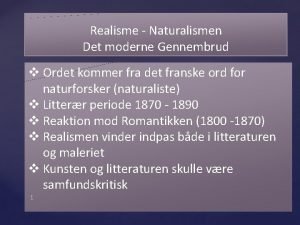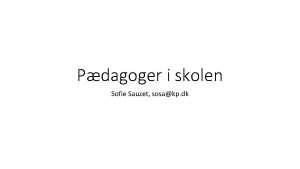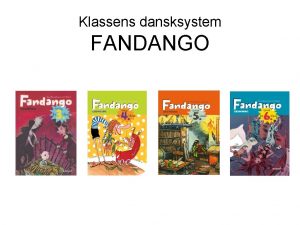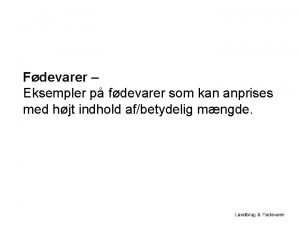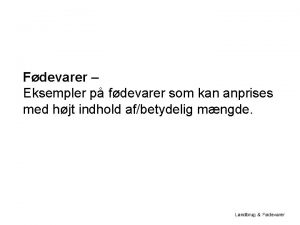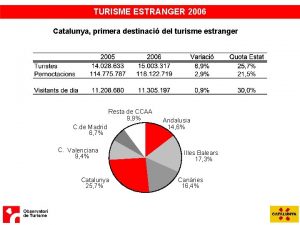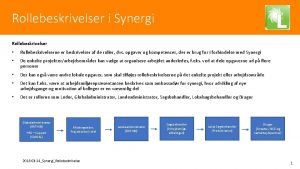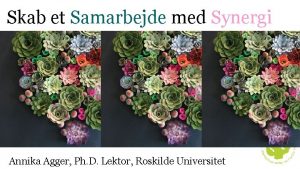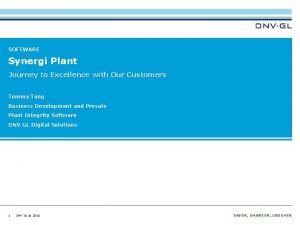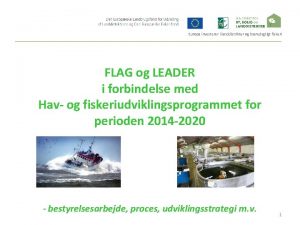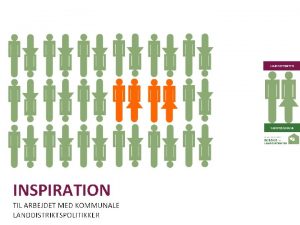SYNERGI MELLEM FDEVARER OG TURISME I LANDDISTRIKTER OG











- Slides: 11

SYNERGI MELLEM FØDEVARER OG TURISME I LANDDISTRIKTER OG YDEROMRÅDER 1. Fødevareturisme: Begrebsmæssige rammer 2. Fødevareturisme: Strategier og praksis’er 3. Case studie preview: Nordjylland Henrik Halkier – halkier@cgs. aau. dk

REVIEWING FOOD TOURISM STRATEGIES Tempting development prospects Ø Ø food increase attraction/brand of destination (Richards 2002, Presenza & Del Chiappa 2013) boost local food production, rural diversification (Hjalager 2002, Hall et al. 2003, Everett & Slocum 2013) cultural sustainability, heritage and regional identity (Long 2004, Sims 2009, Telfer & Hashimoto 2013) environmental sustainability (Hall & Gössling 2013) Aims and methods Bringing together Ø review of literature on food tourism Ø inspiration from institutionalist policy analysis and evolutionary economic geography In order to Ø propose typogy of food tourism strategies Henrik Halkier – halkier@cgs. aau. dk Laura James – laura. james@humangeo. su. se

Food tourism typologies ACTORS, RESOURCES, GOVERNANCE? Consumption Ø more/less important (ex: Hall et al. 2003, Boyne et al. 2003, …. . ) Ø different food qualities in focus (ex: Richards 2002, Long 2004, …. ) Henrik Halkier – halkier@cgs. aau. dk Laura James – laura. james@humangeo. su. se

Food tourism typologies ACTORS, RESOURCES, GOVERNANCE? Consumption Ø more/less important (ex: Hall et al. 2003, Boyne et al. 2003, …. . (? )) Production Ø different food qualities in focus (ex: Richards 2002, Long 2004, …. (? )) Ø Supply chain structures (ex: Hall et al. 2003, Bessiere 2013 (? )) Ø Different types of value added (Hjalager 2002): Volume, quality, services, knowledge Henrik Halkier – halkier@cgs. aau. dk Laura James – laura. james@humangeo. su. se

Food tourism typologies ACTORS, RESOURCES, GOVERNANCE? Consumption Ø more/less important (ex: Hall et al. 2003, Boyne et al. 2003, …. . (? )) Production Ø different food qualities in focus (ex: Richards 2002, Long 2004, …. (? )) Ø Supply chain structures (ex: Hall et al. 2003, …. (? )) Resources Ø Different types of value added (Hjalager 2002): Ø Facilities, activities, events, organisations (ex: Ignatov Smith & Xiao 2008, Everett & Slocum 2013) Volume, quality, services, knowledge Henrik Halkier – halkier@cgs. aau. dk Laura James – laura. james@humangeo. su. se & Smith 2008,

Food tourism typologies ACTORS, RESOURCES, GOVERNANCE? Consumption Ø more/less important (ex: Hall et al. 2003, Boyne et al. 2003, …. . (? )) Production Ø different food qualities in focus (ex: Richards 2002, Long 2004, …. (? )) Ø Supply chain structures (ex: Hall et al. 2003, …. (? )) Resources Ø Different types of value added (Hjalager 2002): Ø Facilities, activities, events, organisations (ex: Ignatov & Smith 2008, Governance Smith & Xiao 2008, Everett & Slocum 2013) Volume, quality, services, knowledge Ø Cross-sectoral integration (Bessiere 2013): § Absent (linked with industrial gastro-tourism) § Emerging (linked with artisanal gastro-tourism) § Established (linked with entrepreneurial gastro-tourism) Henrik Halkier – halkier@cgs. aau. dk Laura James – laura. james@humangeo. su. se

Reconceptualising FOOD TOURISM STRATEGIES Conceptualising regional development strategies (Halkier 2006) Ø Strategies as a combination of aims, targets and instruments Ø Qualitative versus quantative change Ø Targets by sector/size/market Ø (Instruments as change-oriented use of public resources) Food tourism strategies Type of change aims Primary target of change Food Tourism Qualitative Innovation Experience Quantitative Localise consumption Image Henrik Halkier – halkier@cgs. aau. dk Laura James – laura. james@humangeo. su. se

Reconceptualising food tourism: TARGET PRACTICES Reckwitz (2002: 249): Practice as '. . . a routinized type of behaviour which consists of several elements, interconnected to one another: forms of bodily activities, forms of mental activities, ‘things’ and their use, a background knowledge in the form of understanding, know-how, states of emotion and motivational knowledge'. Food tourism practices Social setting Primary attraction Eat Enjoy Commercial Dine Festival Private Cook Fish/hunt Henrik Halkier – halkier@cgs. aau. dk Laura James – laura. james@humangeo. su. se

CASE STUDY Food tourism platform in North Jutland Why? ØBranding, boost local food production, extend tourist season Taking a practice perspective ØKey and marginal actors ØSayings and doings ØPractical concerns ØTemporal organization Interviews & Observation Øfood producers, retailers, policymakers Laura James – laura. james@humangeo. su. se Henrik Halkier– halkier@cgs. aau. dk

Feeding Tourists Food Tourism Producing Food Industrial production of standardized foodstuffs Maximise profits [Some small artisan producers] Small-scale, traditional, creative, local Often ‘lifestyle’ businesses Retailing Supermarkets/national wholesalers Local food market Food network to link producers with restaurants Still no joint distribution Catering Self-catering (bringing food Signature dishes with from home) local ingredients Occasional eating out Story-telling menu Limited seasonality, pre-fab ingredients Promoting Tourism Summer season Families Promotion Laura James – laura. james@humangeo. su. se Henrik Halkier– halkier@cgs. aau. dk Branding region with food Extended season Older wealthier couples Developing initiatives

Key Findings and perspectives Ø Focus on changing practices of retailing, branding and promoting Ø Support for marginalised food production practices, but small scale Ø Some practices ‘too difficult’ to change/link together: buying practices of supermarkets and restaurants Ø Focus on visible practices & new temporality (outside main season) rather than localising food chain Ø Need for reviewing policy practices Ø Underlying assumptions? Ø Cross-sectoral synergies? Ø Strategic black spots? Henrik Halkier – halkier@cgs. aau. dk Laura James – laura. james@humangeo. su. se
